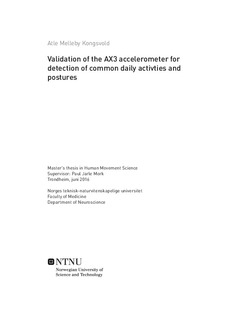| dc.description.abstract | Introduction: Sedentary behavior has been suggested as an independent risk factor for ill-health, with detrimental effects independent of physical activity. However, the exact effect of different types of activity i.e. lying, sitting, standing and walking, on health is uncertain. To obtain precise objective measurements of different types of physical activity and sedentary behavior is therefore of great importance for further research in this field. This study aimed to develop and validate a setup with two tri-axial accelerometers to differentiate between common daily activities and postures. The activity classifiers were developed by use of machine learning algorithms. The classifiers were also compared with the existing benchmark activity classifier Acti4.
Methods: Twenty-two adults (9 males, 13 females) were recruited to the study. Two accelerometers were fixed to the participants, one on the thigh and one on the upper back. The protocol for validation was divided into two sessions, one structured in-lab session emulating common daily activities, and one semi-structured out-of-lab session. Participants were filmed with a video camera during both sessions. The videos were later annotated frame-by-frame and used as criterion for validation. Accelerometer data and video data were synchronized and two different activity classifiers were created, one lab model trained on the structured session (NTNULAB-MODEL), and one model trained and tested on the complete dataset (NTNUADUL). A framework with definitions of activities, postures and transitions were also developed.
Results: The IRR from video annotation were 0.96 (p<0.0001) between three raters. The overall weighted sensitivity of three models were 91% for NTNUADUL, and 87% for NTNULAB-MODEL and Acti4. The sensitivity was >92% for walking, running, standing, sitting, lying down and cycling in NTNUADUL, while specificity was >97% and accuracy >95%. NTNULAB-MODEL had a sensitivity of >89% for running, walking, standing, sitting and lying down. Acti4 had a sensitivity of >81% for the same activities.
Conclusion: The activity classifiers developed in this study were able to detect and differentiate between common daily activities and postures with high sensitivity, specificity and accuracy. | nb_NO |
